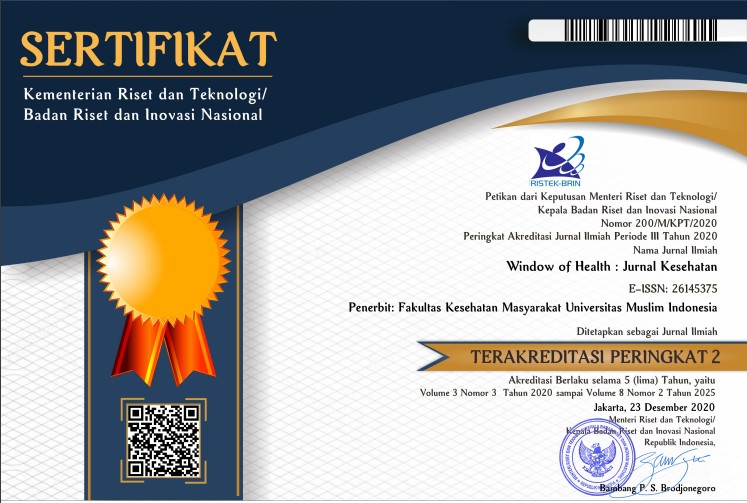Effectiveness of Rosella Flower Syrup on Blood Pressure in Hypertensive Patients with Cholesterolemia
Abstract
Hypertension is one of the causes of repeated morbidity and mortality worldwide. Basic Health Research (Riskesdas) shows an increase in the prevalence of hypertension in Indonesia with ages 18 years and over, from 25.8% in 2013 to 34.1% in 2018. Rosella Flower Syrup, which contains flavonoids ± 40 mg / 4 grams of rosella extract dissolved in 5 ml of distilled water, reduces blood pressure. This research aims to determine whether a 5 ml rosella flower syrup combined with antihypertensive drugs and simvastatin can reduce blood pressure in hypertensive patients with cholesterolemia. This true experimental study used a pre-test and post-test control group design. Forty-eight respondents were selected using the stratified random sampling method through the probability sampling technique. They were divided into two groups; the control group was only given antihypertensive drugs and simvastatin; meanwhile, the intervention group was combined with a 5 ml rosella flower syrup. Rosella flower syrup 5 ml combined with antihypertensive and simvastatin for 14 days can reduce systolic blood pressure (p = 0.000) and diastolic blood pressure (p = 0.033), which means there was a significant difference between the two groups. The conclusion is that five 5ml of Rosella flower syrup combined with antihypertensive drugs and simvastatin can reduce systolic and diastolic blood pressure compared to taking antihypertensive drugs and simvastatin alone. Future research is expected to increase the dose of rosella flower syrup for more than 14 days to get more effective results.
References
Kadir A. Hubungan patofisiologi hipertensi dan hipertensi renal. Jurnal Ilmiah Kedokteran Wijaya Kusuma. 2018;5(1):15-25.
Manuntung NA, Kep M. Terapi perilaku kognitif pada pasien hipertensi: Wineka Media; 2019.
WHO. Hypertension Fack Sheet. 2015 [cited 2020 25 Oktober]; Available from: http://www.searo.who.int/linkfiles/non_communicable_diseases_hypertension-fs.pdf.
RISKESDAS 2018. Jakarta: Kementerian Kesehatan RI; 2018.
Siti Setiati IA, Aru W Sudoyo, et al. Buku Ajar Ilmu Penyakit Dalam Jilid II Edisi VI. Jakarta: Interna Publishing; 2014.
Soeharto I. Penyakit jantung koroner dan serangan jantung. Jakarta: PT. Gramedia Pustaka Utama Halaman; 2004.
Samadani MS, Mardiyono M, Anwar MC. Application of Cupping Therapy with Ginger Aromatherapy on Reducing Cholesterol Level among Patients with Hypercholesterolemia. International Journal of Nursing and Health Services (IJNHS). 2021;4(1):17-27.
Indonesia D. Pharmaceutical Care Untuk Penyakit Hipertensi: Direktorat Bina Farmasi Komunitas dan Klinik Ditjen Bina Kefarmasian dan Alat Kesehatan. Jakarta Indonesia. 2006.
Posadzki P, Cramer H, Kuzdzal A, Lee MS, Ernst E. Yoga for hypertension: a systematic review of randomized clinical trials. Complementary Therapies in Medicine. 2014;22(3):511-22.
Aleyeidi N, Aseri K, Kawthar A. The efficacy of wet cupping on blood pressure among hypertension patients in Jeddah, Saudi Arabia: A randomized controlled trial pilot study. Altern Integr Med. 2015;4:183.
Luo J, Xu H, Liu B. Real world research: a complementary method to establish the effectiveness of acupuncture. BMC complementary and alternative medicine. 2015;15(1):153.
Xiong X, Li X, Zhang Y, Wang J. Chinese herbal medicine for resistant hypertension: a systematic review. BMJ open. 2015;5(1).
Eguchi E, Funakubo N, Tomooka K, Ohira T, Ogino K, Tanigawa T. The effects of aroma foot massage on blood pressure and anxiety in Japanese community-dwelling men and women: A crossover randomized controlled trial. PloS one. 2016;11(3):e0151712
Pujiastuti RSE, Sawab S, Afiyati SZ. Pengaruh Terapi Yoga Terhadap Penurunan Tekanan Darah Pada Penderita Hipertensi. Jurnal Perawat Indonesia. 2019;3(1):36-47.
Maisi S, Suryono S, Widyawati MN, Suwondo A, Kusworowulan S. Effectiveness of lavender aromatherapy and classical music therapy in lowering blood pressure in pregnant women with hypertension. Belitung Nursing Journal. 2017;3(6):750-6.
Hariyanti R, Hadisaputro S, Sumarni S, Widyastuti E. The Effectiveness of Cucumber Suri Juice (Cucumis Sativus) On Blood Pressure In Menopausal Hypertension. STRADA Jurnal Ilmiah Kesehatan. 2020;9(2):1771-8.
Apriliyanti D, Tambunan LN. Pengaruh Pemberian Ekstrak Kelopak Bunga Rosella Terhadap Penurunan Kadar Tekanan Darah pada Penderita Hipertensi di Puskesmas Pahandut Palangka Raya Kalimantan Tengah. Dinamika Kesehatan: Jurnal Kebidanan Dan Keperawatan. 2018;9(2):269-76.
Yunia A, Suhariyanti E, Priyanto S. Perbedaan Efektivitas Rebusan Ketumbar dengan Rebusan Kunyit terhadap Tekanan Darah pada Lansia Hipertensi. Proceeding of The URECOL. 2019:676-87.
Kwon E-K, Lee D-Y, Lee H, Kim D-O, Baek N-I, Kim Y-E, et al. Flavonoids from the buds of Rosa damascena inhibit the activity of 3-hydroxy-3-methylglutaryl-coenzyme a reductase and angiotensin I-converting enzyme. Journal of agricultural and food chemistry. 2010;58(2):882-6.
Masriadi, Hasta Handayani Idrus,, Alfina Baharuddin, Epidemiologi Kejadian Hipertensi Window of Health : Jurnal Kesehatan, Vol. 5 No. 2 (April, 2022) : 592-60.Http: file:///C:/Users/JURNAL/Downloads/47-Article%20Text-149-1-10-20220522%20(3).pdf








